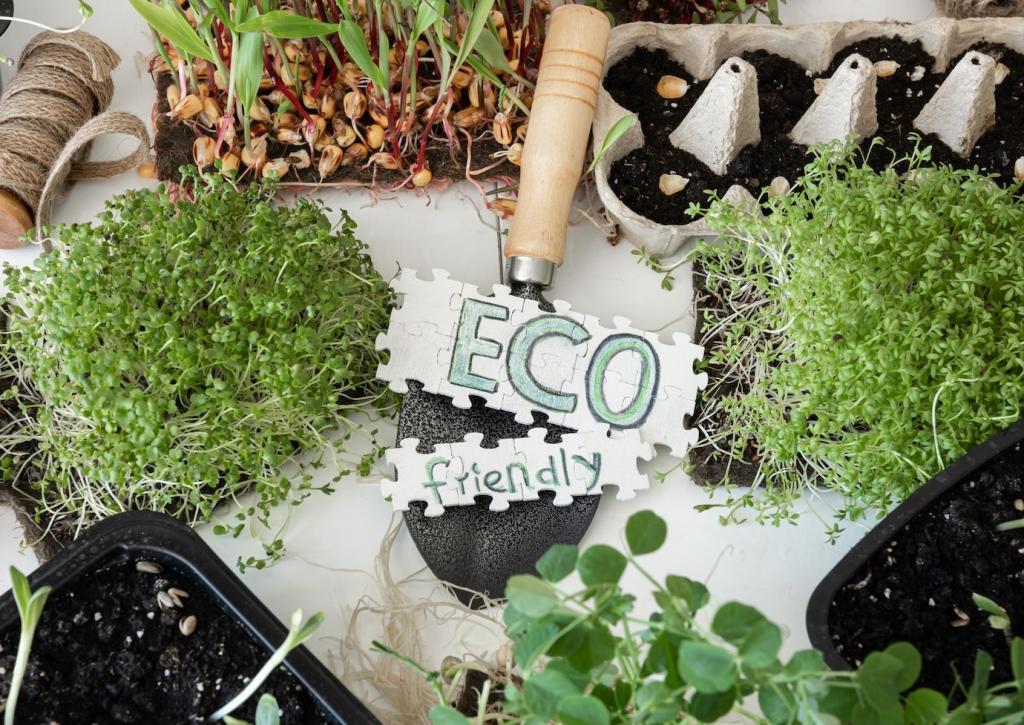Sustainable Material Innovations in Fashion
Previous slide
Next slide

Bio-Based Fibers: Nature’s Blueprint for Fashion
Organic Cotton: Enhanced Sustainability and Comfort
Organic cotton eliminates the use of synthetic pesticides and fertilizers, thus protecting soil health and reducing water consumption. The fibers are hypoallergenic and biodegradable, making them kinder to both the wearer and the environment. Additionally, organic farming practices often encourage biodiversity and fair labor, addressing both ecological and social dimensions of sustainability.
Hemp and Linen: Ancient Solutions for Modern Needs
Hemp and linen, derived from flax, are among the oldest fibers used by humans. They require far less water and chemical input than mainstream crops like cotton. Robust and durable, these fibers grow rapidly in diverse conditions, replenish soil nutrients, and produce fabric that naturally resists pests and mildew, making them ideal choices for a conscientious industry.
Innovative Bioplastics: From Plants to Polymers
Emerging bioplastic fibers utilize plant sources such as corn, sugarcane, or bamboo to create textiles resembling traditional synthetics. These materials can be engineered for durability and stretch, while being compostable or recyclable at the end of life. As technology evolves, bioplastics are moving closer to mass-market viability, potentially replacing petroleum-based fabrics across mainstream collections.

Regenerative Agriculture in Textile Production
Soil Health and Biodiversity
Regenerative farming methods, such as cover-cropping, no-till practices, and rotational grazing, enhance soil structure and promote biodiversity. This not only produces higher quality fibers but also draws carbon dioxide from the atmosphere, combating climate change. Healthy, living soils support resilient agricultural systems crucial for the future of natural textile production.
Carbon Sequestration and Climate Resilience
Through techniques that boost organic matter in soils, regenerative agriculture actively sequesters carbon, reducing greenhouse gas concentrations. Crops grown in these systems are more resilient to droughts and floods, ensuring a consistent supply of sustainable fibers even as climate change intensifies. Fashion brands using these materials contribute tangibly to climate mitigation.
Partnerships with Farming Communities
Collaborations between brands and regenerative farmers foster transparent, equitable supply chains. By investing in farmer education, fair pricing, and long-term contracts, the fashion industry supports communities while gaining access to superior raw materials. These partnerships encourage a circular, mutually beneficial relationship between fashion and agriculture.
Closed-Loop Textiles and Circular Fashion
Textile Recycling Technologies
Advanced recycling methods now enable the breakdown and reformation of fibers at the molecular level. Chemical recycling can convert used garments into new textiles of equal quality, closing the loop on polyester and cotton. As large-scale infrastructure develops, these technologies promise to significantly cut textile waste and resource consumption.
Upcycling and Creative Redesign
Upcycling involves transforming discarded garments and factory offcuts into valuable new products. By leveraging creative design, brands and artisans breathe new life into what would otherwise be landfill-bound textiles. This approach not only reduces waste but also results in unique pieces, offering consumers the chance to participate in fashion’s shift toward circularity.
Take-Back and Repair Initiatives
Many forward-thinking brands are implementing programs that encourage consumers to return used clothing for recycling or repair. These initiatives extend the lifespan of garments, reduce landfill waste, and cultivate loyalty by promoting responsible consumption. Making repair services easily accessible sets a new standard for fashion professionals and shoppers alike.
Low-Impact Dyeing and Finishing Technologies
Waterless and Digital Dyeing
Recent technologies allow fabrics to be colored without the enormous volumes of water traditionally required. Techniques such as supercritical CO2 dyeing and digital printing eliminate aqueous waste and deliver vivid, customized results. Brands adopting these methods appeal to eco-minded consumers while significantly reducing their environmental footprint.
Plant-Based and Non-Toxic Dyes
Harnessing pigments from natural sources—such as roots, leaves, and minerals—replaces hazardous synthetic dyes. These alternatives are biodegradable, reduce risk to workers, and create subtle, sophisticated hues. Brands embracing botanical dyes reconnect fashion with nature, offering environmentally safe and visually compelling collections.
Mechanical and Enzymatic Finishing
Finishing textiles for softness, strength, or wrinkle resistance often involves harmful chemicals. Mechanical processes, like sand-washing, or the use of specialized enzymes, achieve comparable effects without hazardous residues. This shift ensures safety for factory workers, wearers, and local environments, making sustainable finishing a new industry standard.
Next-Generation Synthetic Alternatives
Through the collection and reprocessing of plastic bottles, discarded fishing nets, and post-consumer waste, new fibers are produced that mimic the durability of virgin synthetics. This reduces landfill volume, curtails ocean plastic, and lowers overall resource extraction. Brands utilizing recycled synthetics demonstrate that performance and sustainability are not mutually exclusive.

Transparency, Traceability, and Digital Tools
Digital ledgers like blockchain technology offer immutable records of every stage in a material’s journey, from farm to finished garment. This transparency deters fraud, ensures authenticity, and enables brands to substantiate their sustainability claims. By providing accessible data, blockchain advances both accountability and consumer confidence.
International standards and independent auditors assess everything from organic content to labor conditions. Certifications like GOTS or OEKO-TEX guide brands and consumers towards truly sustainable offerings. These third-party verifications distinguish authentic initiatives from greenwashing and support the scaling of industry-wide best practices.
Educating buyers about material origins and lifecycle impacts fosters informed decision-making. Forward-thinking brands now provide apps and product labels that share detailed sourcing, carbon footprint, or social impact facts. Such radical openness cultivates trust and motivates shoppers to support innovation-driven sustainability.
Collaborations and Cross-Industry Partnerships

Brand-Innovation Lab Collaborations
Major fashion labels are increasingly partnering with startups and research labs to accelerate the development and deployment of sustainable materials. By funding pilots and scaling new technologies, these collaborations bridge the gap between scientific discovery and everyday products, making sustainability accessible to mainstream audiences.

Cross-Sector Circular Ecosystems
Partnerships that extend beyond the fashion sector—such as alliances with the food industry for agricultural byproducts, or waste management companies for recycling infrastructure—are essential for building closed-loop models. These circular ecosystems maximize resource efficiency, minimize environmental harm, and create value at every stage.

Community-Led and Artisan Networks
Local artisans and smallholder producers often possess invaluable knowledge of traditional sustainable practices. Collaborating with these communities not only preserves cultural heritage but also helps scale eco-friendly materials by blending time-tested wisdom with modern technology. Brands engaged in community partnerships elevate social and environmental responsibility together.
